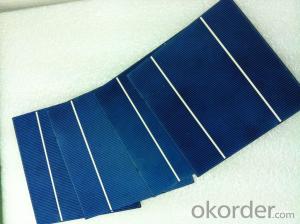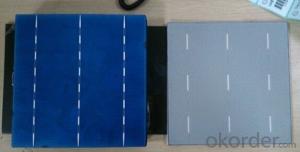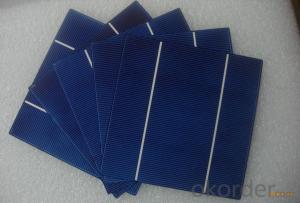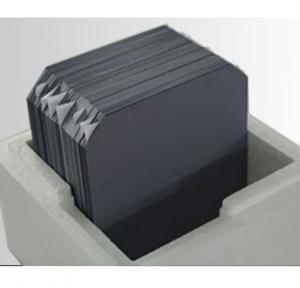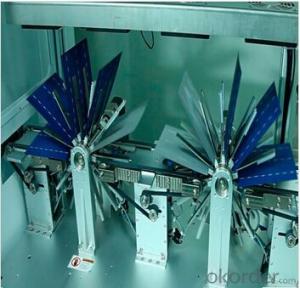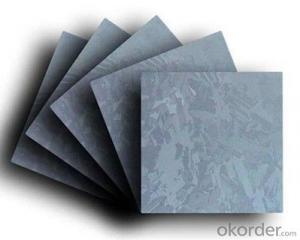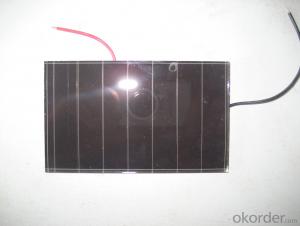Solar Cell High Quality A Grade Cell Polyrystalline 5v 16.6%
- Loading Port:
- Shanghai
- Payment Terms:
- TT OR LC
- Min Order Qty:
- 1000 pc
- Supply Capability:
- 100000 pc/month
OKorder Service Pledge
OKorder Financial Service
You Might Also Like
Specifications
hot sale solar cell
1.16.8%~18.25% high efficiency
2.100% checked quality
3.ISO9001/ISO14001/TUV/CE/UL
4.stable performance
We can offer you the best quality products and services, don't miss !
POLY6'(156*156)
Polycrystalline Silicon Solar cell
Physical Characteristics
Dimension: 156mm×156mm±0.5mm
Diagonal: 220mm±0.5mm
Thickness(Si): 200±20 μm
Front(-) Back(+)
Blue anti-reflecting coating (silicon nitride); Aluminum back surface field;
1.5mm wide bus bars; 2.0mm wide soldering pads;
Distance between bus bars: 51mm . Distance between bus bars :51mm .
Electrical Characteristics
Efficiency(%) | 18.00 | 17.80 | 17.60 | 17.40 | 17.20 | 16.80 | 16.60 | 16.40 | 16.20 | 16.00 | 15.80 | 15.60 |
Pmpp(W) | 4.33 | 4.29 | 4.24 | 4.19 | 4.14 | 4.09 | 4.04 | 3.99 | 3.94 | 3.90 | 3.86 | 3.82 |
Umpp(V) | 0.530 | 0.527 | 0.524 | 0.521 | 0.518 | 0.516 | 0.514 | 0.511 | 0.509 | 0.506 | 0.503 | 0.501 |
Impp(A) | 8.159 | 8.126 | 8.081 | 8.035 | 7.990 | 7.938 | 7.876 | 7.813 | 7.754 | 7.698 | 7.642 | 7.586 |
Uoc(V) | 0.633 | 0.631 | 0.628 | 0.625 | 0.623 | 0.620 | 0.618 | 0.617 | 0.615 | 0.613 | 0.611 | 0.609 |
Isc(A) | 8.709 | 8.677 | 8.629 | 8.578 | 8.531 | 8.478 | 8.419 | 8.356 | 8.289 | 8.220 | 8.151 | 8.083 |
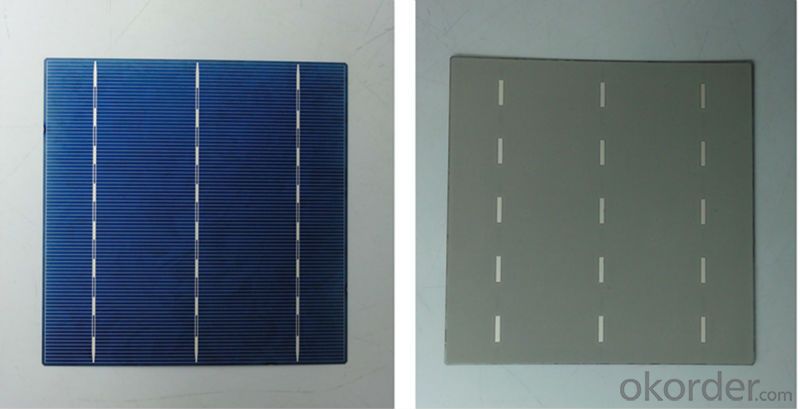
MONO5'(125*125mm)165
Monocrystalline silicon solar cell
Physical Characteristics
Dimension: 125mm×125mm±0.5mm
Diagonal: 165mm±0.5mm
Thickness(Si): 200±20 μm
Front(-) Back(+)
Blue anti-reflecting coating(silicon nitride); Aluminum back surface field;
1.6mmwide bus bars; 2.5mm wide soldering pads;
Distance between bus bars: 61mm . Distance between bus bars :61mm .
Electrical Characteristics
Efficiency(%) | 19.40 | 19.20 | 19.00 | 18.80 | 18.60 | 18.40 | 18.20 | 18.00 | 17.80 | 17.60 | 17.40 | 17.20 |
Pmpp(W) | 2.97 | 2.94 | 2.91 | 2.88 | 2.85 | 2.82 | 2.79 | 2.76 | 2.73 | 2.70 | 2.67 | 2.62 |
Umpp(V) | 0.537 | 0.535 | 0.533 | 0.531 | 0.527 | 0.524 | 0.521 | 0.518 | 0.516 | 0.515 | 0.513 | 0.509 |
Impp(A) | 5.531 | 5.495 | 5.460 | 5.424 | 5.408 | 5.382 | 5.355 | 5.328 | 5.291 | 5.243 | 5.195 | 4.147 |
Uoc(V) | 0.637 | 0.637 | 0.636 | 0.635 | 0.633 | 0.630 | 0.629 | 0.629 | 0.628 | 0.626 | 0.626 | 0.625 |
Isc(A) | 5.888 | 5.876 | 5.862 | 5.848 | 5.839 | 5.826 | 5.809 | 5.791 | 5.779 | 5.756 | 5.293 | 5.144 |

FAQ:
Q:How can i get some sample?
A:Yes , if you want order ,sample is not a problem.
Q:How about your solar panel efficency?
A: Our product efficency around 17.25%~18.25%.
Q:What’s the certificate you have got?
A: we have overall product certificate of ISO9001/ISO14001/CE/TUV/UL
- Q:Development trend of monocrystalline silicon wafer
- Speaking of silicon, we have to mention Chinese LDK! The world's largest manufacturer of solar wafers - Jiangxi LDK LDK Solar Co. Ltd., announced in September 20, 2008, the company has been successful in the United States on a day before the issuance of 4 million 800 thousand shares of American Depositary Shares (ADS), for the price of $41.75, to raise funds of $200 million, mainly for polysilicon plant and wafer factory expansion.It is reported that LDK LDK will use 60% of the net proceeds of the issuance of the company to support the construction of polysilicon plant, the use of polysilicon to expand the production capacity of 30%, for the general business activities of 10%.
- Q:How are solar silicon wafers connected in a solar array?
- Solar silicon wafers are typically connected in a solar array through a process called soldering. Soldering involves joining the wafers together using a conductive material, such as silver paste or copper ribbon, which creates electrical connections between the individual cells. This allows the solar cells to work collectively and generate electricity when exposed to sunlight.
- Q:Are solar silicon wafers affected by humidity?
- Yes, solar silicon wafers can be affected by humidity. High humidity levels can impact the performance and efficiency of solar cells made from silicon wafers. Moisture can cause corrosion, reduce electrical conductivity, and potentially damage the surface of the wafers. Therefore, it is important to protect solar silicon wafers from excessive humidity to ensure optimal functionality and longevity.
- Q:How are solar silicon wafers protected from theft or unauthorized use?
- Solar silicon wafers are typically protected from theft or unauthorized use through various security measures. These can include physical security measures such as restricted access to manufacturing facilities and storage areas, surveillance systems, and alarm systems. Additionally, strict inventory control and tracking systems are implemented to ensure that each wafer is accounted for and can be traced back to its origin. These measures help deter theft and unauthorized use, ensuring the security and integrity of solar silicon wafers.
- Q:How does the efficiency of a solar silicon wafer change with altitude?
- The efficiency of a solar silicon wafer typically increases with altitude. This is due to a few factors. Firstly, at higher altitudes, there is often less pollution and atmospheric interference, allowing more sunlight to reach the solar panel. Additionally, the lower temperatures at higher altitudes can improve the performance of solar cells as they operate more efficiently in cooler conditions. However, it is important to note that the increase in efficiency with altitude may vary depending on the specific location and environmental conditions.
- Q:What is the typical cost of a solar silicon wafer?
- The typical cost of a solar silicon wafer can vary depending on various factors such as size, quality, and market conditions. However, on average, a solar silicon wafer can range from around $0.10 to $0.50 per watt, with larger and higher-quality wafers tending to be more expensive.
- Q:How is a power optimizer integrated into a solar silicon wafer?
- A power optimizer is typically integrated into a solar silicon wafer by connecting it between the individual solar cells and the junction box. The power optimizer acts as a DC-DC converter, optimizing the power output of each individual solar cell by constantly tracking and adjusting the maximum power point. This optimization process allows for increased energy production and better performance, even in cases where the solar panels are not perfectly aligned or shaded.
- Q:What is the impact of impurities in solar silicon wafers on performance?
- The presence of impurities in solar silicon wafers can have a significant impact on their performance. Impurities, such as boron, phosphorus, or metal contaminants, can affect the electrical properties of the wafers, leading to reduced efficiency and performance of solar cells. Impurities can introduce defects or alter the crystal structure of the silicon, affecting the flow of electrons and holes within the material. This can result in increased recombination rates, reducing the overall efficiency of converting sunlight into electricity. Furthermore, impurities can also lead to increased resistance within the solar cell, hindering the flow of current. This can decrease the output power and overall performance of the solar panel. To ensure optimal performance, manufacturers strive to produce high-purity silicon wafers with minimal impurities. This involves careful purification processes and quality control measures to minimize the presence of impurities and maximize the efficiency of the solar cells.
- Q:What is the typical energy payback time for a solar silicon wafer?
- The typical energy payback time for a solar silicon wafer is around 1 to 2 years.
- Q:How do solar silicon wafers perform in low-temperature environments?
- Solar silicon wafers generally perform well in low-temperature environments. The efficiency of solar cells tends to increase with lower temperatures, as cooler temperatures reduce the resistance and losses within the cells. However, extremely low temperatures can cause a slight decrease in performance due to reduced mobility of charge carriers. Overall, solar silicon wafers are designed to withstand and function effectively in a wide range of temperatures, including low-temperature environments.
1. Manufacturer Overview |
|
|---|---|
| Location | |
| Year Established | |
| Annual Output Value | |
| Main Markets | |
| Company Certifications | |
2. Manufacturer Certificates |
|
|---|---|
| a) Certification Name | |
| Range | |
| Reference | |
| Validity Period | |
3. Manufacturer Capability |
|
|---|---|
| a)Trade Capacity | |
| Nearest Port | |
| Export Percentage | |
| No.of Employees in Trade Department | |
| Language Spoken: | |
| b)Factory Information | |
| Factory Size: | |
| No. of Production Lines | |
| Contract Manufacturing | |
| Product Price Range | |
Send your message to us
Solar Cell High Quality A Grade Cell Polyrystalline 5v 16.6%
- Loading Port:
- Shanghai
- Payment Terms:
- TT OR LC
- Min Order Qty:
- 1000 pc
- Supply Capability:
- 100000 pc/month
OKorder Service Pledge
OKorder Financial Service
Similar products
New products
Hot products
Hot Searches
Related keywords
